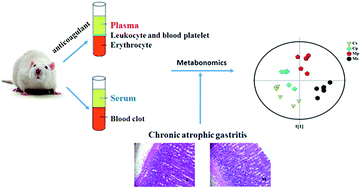A comparison of serum and plasma specimens in NMR-based metabonomics and its application in chronic atrophic gastritis rats†
Abstract
The choice of blood specimens is still disputable in metabonomic studies due to the great metabolic diversities of serum and plasma. In the present work, a proton nuclear magnetic resonance spectroscopy (NMR)-based metabonomic approach was introduced to explore metabolic differences between serum and plasma coupled with its application in the pathogenesis of chronic atrophic gastritis (CAG). As a result, 3 and 20 identified metabolites were applied to characterize the metabolic differences between serum and plasma, respectively, in control or CAG rats, which might be related to the effect of anticoagulants. Almost all the metabolic contents except lactate and β-glucose in serum samples were higher than those in plasma samples. Meanwhile, 12 serum and 11 plasma potential biomarkers were detected to relate to the formation of CAG by comparisons of the normal and CAG groups, respectively. Receiver operating characteristic analysis (ROC) also showed that serum specimens were clearly superior to plasma based on sensitivity of the diagnosis of CAG. The results showed that the combination of them could enhance the metabolic coverage related to the mechanism of CAG, which involves oxidative stress, energy failure, cell injury and death. Furthermore, selecting a serum specimen might be a good way to investigate the blood metabolome, especially under pathological states. This may favor the use of serum rather than plasma in NMR-based metabonomics.

- This article is part of the themed collection: Analytical Methods Recent HOT articles


 Please wait while we load your content...
Please wait while we load your content...